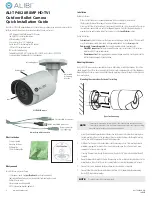
AXIS P1435–LE Network Camera
Video
Note that an Exclude window is effective only when placed inside an include window.
Tip: If an area is extremely bright draw an Include window to cover the whole area and define Exclude windows within it to
block out the bright areas.
Shutter & Gain
The shutter and gain settings affect the amount of motion blur and noise in the image. To adapt to different lighting, available
storage space and bandwidth, it is often necessary to prioritize either low motion blur or low noise. The Axis product allows
using different prioritization in normal light and in low light.
Shutter speed
is related to the amount of time the shutter is opened and is measured in seconds (s). A slow shutter speed allows
more light to reach the sensor and can help produce a brighter image in low light situations. On the other hand, a slow shutter
speed can cause moving objects to appear blurry.
Set
Wide Dynamic Range
to
WDR Off
and set
Shutter
to
•
Auto
to set the shutter speed automatically. If required, use
Max shutter
to limit the shutter speed to prevent the frame
rate from being reduced.
For example, to get 30 fps, set Max shutter to 1/30.
•
Fixed
to use a fixed shutter speed.
Gain
, measured in decibel (dB), is the amount of amplification applied to the image. A high gain may provide a better image in low
light situations but will increase the amount of image noise.
Set
Gain
to
•
Auto
to set the gain automatically. If required, use
Max gain
to limit the applied gain.
•
Fixed
to use a fixed gain.
When
Shutter
and
Gain
are both set to
Auto
, it is possible to set the
Priority
between low motion blur and low noise manually and to
use a different
Priority
in
Normal Light
and in
Low Light
.
Example
Consider an area where people or vehicles move during the day, but where there should be no movements during night. To be able to,
for example, recognize faces or license plates, move the normal light priority slider toward low motion blur. At nighttime, motion
detection is more important than identification. Motion blur is acceptable and since low light can cause a lot of noise, move
the low light priority slider toward low noise.
Example
If storage space or bandwidth is limited, try using a lower gain. This will reduce image noise and produce smaller image files.
Iris adjustment
Select
Enable automatic iris adjustment
to automatically compensate for changing light conditions. This option is not available
if a fixed iris is used.
Use the
Iris adjustment
slider to set the preferred F-value. The scale represents the amount the iris is open. If set to 0, the iris is
opened as much as possible. If set to 100, the iris is closed as much as possible. The actual F-value is shown below the slider. If
automatic iris adjustment is enabled, the iris will stay at this position as long as light conditions are favorable. If light conditions
change, the iris will adjust itself to the best iris settings. If automatic iris adjustment is disabled, the iris will lock on the set
position regardless of light conditions
Day/Night
The IR cut filter prevents infrared (IR) light from reaching the image sensor. In poor lighting conditions, for example at night, or when
using an external IR lamp, set the IR cut filter to
Off
. This increases light sensitivity and allows the product to “see” infrared light. The
image is shown in black and white when the IR cut filter is off.
21
Содержание P1435-LE
Страница 1: ...AXIS P1435 LE Network Camera User Manual...
















































